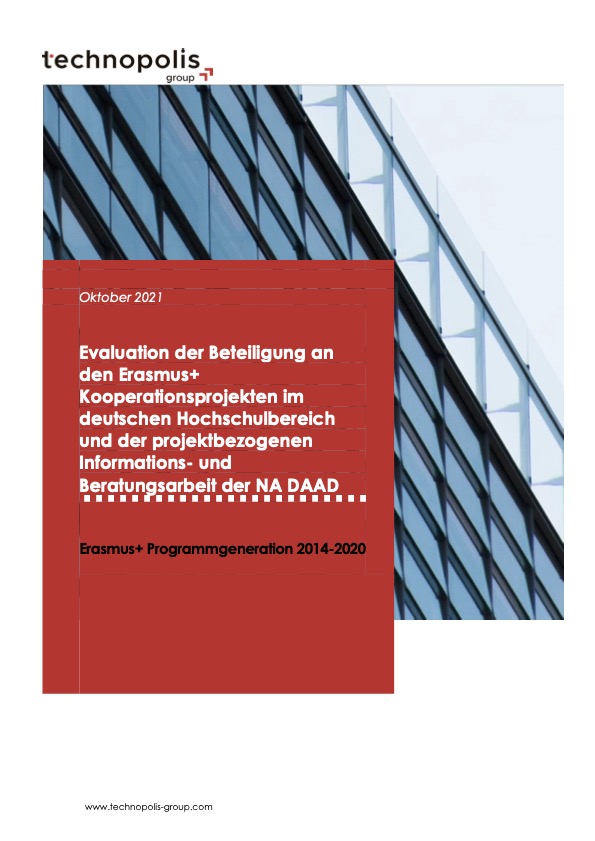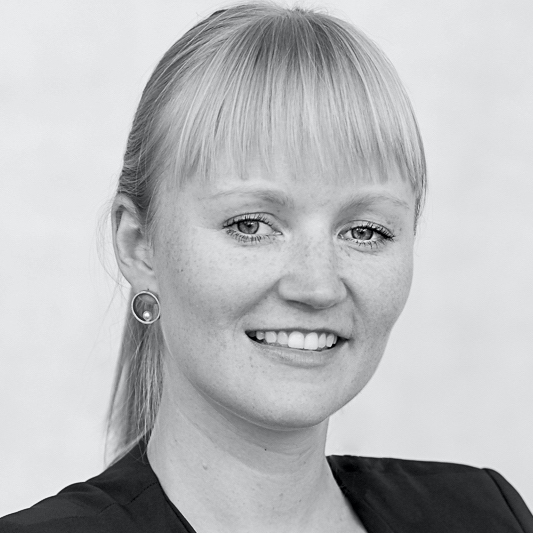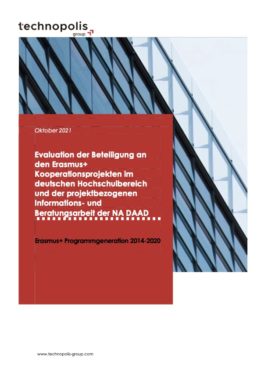Evaluation of the participation of the German Higher Education sector in Erasmus+ cooperation projects
Publication date: 10 Februar 2022 | Report language: DE
Erasmus+ Programme generation
2014-2020
The Erasmus+ Programme to support education, training, youth and sport in Europe promotes both individual mobility and cooperation projects in the higher education sector between European institutions and partner countries around the world. The Erasmus+ cooperation related funding lines support academic cooperation and German higher education institutions (HEIs) in the further development and implementation of their internationalisation strategies. These funding lines aim to contribute to the further development of the European Higher Education Area and the European Research Area. The study at hand focuses on the programme period 2014-2020 and analyses the following eight cooperation-related funding lines:
- Strategic Partnerships
- Capacity Building in Higher Education
- Erasmus Mundus Joint Master Degrees (EMJMD)
- Knowledge Alliances for Higher Education
- Jean Monnet actions
- Forward looking cooperation projects
- Policy experimentations
- Social inclusion through education, training and youth
The project types in these funding lines differ significantly in their orientation: from master’s degree programmes (EMJMD) to cooperation projects between (primarily) HEIs in Europe (Strategic Partnerships) and outside Europe (Capacity Building projects) as well as economic actors (Knowledge Alliances) to projects with political objectives, i.e. with a focus on EU studies (Jean Monnet) or a focus on policy support in various educational areas (Forward looking cooperation projects, Policy experimentations, Social inclusion through education, training and youth).
The present evaluation aims to provide more detailed information on the programme participation of HEIs in Germany, their motivations to participate, the project results and the supporting role of the NA DAAD within the framework of the Erasmus+ cooperation-related funding lines1. The following evaluation questions are addressed:
- A quantitative evaluation of the programme participation of German HEIs and other institutions in the education sector was carried out.
- Furthermore, the evaluation gives insight into the objectives and motivations of HEIs for participating in the Erasmus+ funding lines. The evaluation is based on the assumption that HEIs pursue their own and sometimes implicit goals beyond the objectives of Erasmus+. The analysis of the relevance of the funding lines for the HEIs, the achievement of the university’s own objectives and the results achieved, as well as the sustainability of the project results were at the forefront of the evaluation.
- Lastly, the effectiveness of the information and advisory services of the NA DAAD was evaluated regarding the support for applications and project implementation.
These questions were analysed using a combination of quantitative and qualitative methods. Specifically, this includes extensive document and secondary data analysis, qualitative approaches via an interview programme and focus groups with HEI representatives and other Erasmus+ experts as well as an online survey among project participants to collect quantitative data. Generally, it must be noted that the study is characterised by a high level of complexity: On the one hand, this is reflected in the variety of funding lines to be examined, some of which differ significantly in character; on the other hand, this is reflected in the heterogeneity of the evaluation questions. Accordingly, the evaluation results allow a variety of overarching conclusions, but detailed analyses – e.g., differentiated according to the individual funding lines – can only be carried out to a limited extent. Overall, the mix of methods and a final validation in a total of five focus groups allow for a solid data base to answer the evaluation questions.
Participation in Erasmus+ cooperation-related funding lines
Overall, between 2014 and 2020, 217 HEIs with a total of 1193 projects have been involved in the Erasmus+ cooperation-related funding lines. This corresponds to a little more than half of all 406 HEIs in Germany. While 88% of all German universities and all of the six pedagogical universities take part, 43% of the universities of applied sciences (UAS) and 25% of universities of art/music participate. Universities are the most often involved type of HEIs in most funding lines; only in the Strategic Partnerships is a larger proportion of UAS represented.
In a European comparison, the participation of German institutions overall is at a high level: Germany is always among the top seven countries with the most projects in all eight funding lines, and in some funding lines also in the top 3. Due to a substantial budget increase, participation in the decentralized Strategic Partnerships strongly increased from 2016 onwards. Over the programme period 2014-2020, in most of the other funding lines, no trend towards increased participation by German institutions as coordinators or trends in the success rate of applications coordinated by German institutions can be identified. Nevertheless, there has been an increase in the funding volume for Erasmus+ cooperation projects with German coordinators, as well as a stable high level of participation in the centrally organized funding lines.
Central to this study is the analysis of participation patterns, i.e. the analysis of the frequency with which individual or different funding lines are used by HEIs. In the evaluation, the use of several funding lines – as one possible approach among many – is interpreted as an indication of a possible strategic use of the portfolio of Erasmus+ cooperation projects, meaning that the use is not limited to the project managers at the HEIs. The analysis shows that half of the HEIs focus on one funding line while almost a quarter of the HEIs are involved in two funding lines. There are differences in the participation patterns between the different types of HEIs: Almost 70% of universities use more than one funding line, with most universities participating in two to four funding lines. A particularly broad portfolio of funding lines with more than four funding lines and many projects is almost exclusively used by large universities. The vast majority of UAS participate in one or two funding lines. According to the interviews, a plausible explanation of these differences could be that the application for and implementation of the Erasmus+ cooperation projects is facilitated by sufficient resources and support at the HEIs; after all, the different types of HEIs differ in their framework conditions, resources and support structures (e.g., teaching load, support structures for third-party funding, staff in mid-level faculties). Programme participation also becomes more likely the larger the HEI is, due to the higher number of potential applicants. The broad involvement of universities in particular, however, does not allow for conclusions to be drawn regarding the strategic use of various funding lines, but is primarily based on the commitment of individual HEI representatives. For this reason, the question of strategic use was also examined in qualitative interviews (see below).
Objectives and approaches to Erasmus+ cooperation projects
The second evaluation question focuses on the objectives pursued by HEIs participating in Erasmus+ cooperation projects. In this study, the objectives are categorised as
- intrinsic / content-related motivators (e.g., further development of one’s own academic work, increased visibility of a specific topic, societal/political impact),
- cooperation-related motivators (establishment and expansion of international networks)
- and strategic motivators (i.e. goals regarding the reputation, competitiveness and visibility of the HEI as a whole).
The results show that the cooperation-related as well as intrinsic / content-related motivators are paramount to the Erasmus+ project participants. The establishment and expansion of professional networks in particular is one of the most important objectives in all funding lines. Content-related motivators such as the increased visibility of the project topic, societal impact, or improved teaching also play an important role. Increased visibility and reputation of the HEIs – strategic motivators – are also key objectives. Depending on the funding line, there are different priorities in the motivators of those involved in the projects. What all funding lines have in common is the high importance of cooperation-related goals.
The Erasmus+ projects are almost exclusively initiated by the project participants themselves or by partner organisations, i.e., primarily via a bottom-up approach: Thematic interests and networks usually form the basis for emerging projects. The projects are less frequently explicitly embedded in the internationalisation strategies of the HEIs or steered by the HEIs executive/ strategy level. As part of the evaluation, however, examples could also be identified in which the implementation of Erasmus+ cooperation projects is strategically supported and/or these are specifically used for the implementation of internationalisation strategies. There is a tendency towards a strategic approach and explicit institutional links within small and medium sized universities, pedagogical universities and (larger) UAS. According to the interviews, one reason for this could be that the relative, strategic importance of the funding lines is higher at these HEIs than, for instance, projects from EU research programmes.
Outcomes and sustainability of the Erasmus+ cooperation projects
In accordance with the cooperation-related objectives of the project participants, the evaluation shows that the expansion of professional networks is one of the most important outcomes of the Erasmus+ cooperation projects. The other most important outcomes include improved teaching methods and content, increased visibility of the respective project topic, and increased visibility of the respective HEI. These central outcomes are primarily at the level of project representatives. Other, unintended effects include, for example, the broader use of the project results on the subject of digital education and / or virtual mobility at HEIs due to the COVID-19 pandemic, which resulted in increased digitisation at HEIs. Furthermore, some project participants also used their projects for the preparation of other funding initiatives.
The project participants especially consider the formation of networks, an expanded range of teaching content and methods as well as the further development and publication of their own scientific work as sustainable. Nevertheless, ensuring the sustainability of the specific project results is a challenge for many of those involved in the projects, for instance due to not introducing the developed teaching modules in HEI curricula because of different interpretations of educational systems or HEI requirements. A lack of permanent staffing as well as follow-up financing – e.g., for joint follow-up activities, the further development of the project results or elements specific to the funding line (e.g., EMJMD scholarships) – can compromise sustainability.
The NA DAAD information and advisory services
A success factor for the implementation of the Erasmus+ cooperation projects is, among other aspects, the support of the HEIs provided by the NA DAAD. The information and advisory services offered by the NA DAAD comprise a number of elements, including events, information materials and personal consultation. The consultation is guided by the approach „from the idea to the project“, i.e., the NA DAAD aims to provide comprehensive advice to project representatives and interested parties throughout the funding cycle, especially regarding the matching of project ideas and funding lines.
Around two thirds of the surveyed project participants have already used the information and advisory services. It can be highlighted that both the survey participants and the project participants in the interviews and focus groups are almost exclusively satisfied with the work of the NA DAAD. The events and personal consultations are the most positively rated services; the latter is perceived as needs-oriented, in-depth and dedicated. The information material available is slightly less popular, but it is still viewed as helpful by the majority. In this context, it was pointed out in interviews that documents with more concise, target group-oriented messages and content could be helpful in addition: not only for those interested to inform themselves about the specific potential of the funding lines for their own work and their own HEI, but in order to pass the information on to the respective HEI administration and management.
A positive highlight is the effective support within the application process as well the support in the implementation of the projects. Overall, a majority of project representatives consider their needs for advice and support covered by the NA DAAD.
Conclusion
Various aspects of the overarching added values and strengths of the Erasmus+ cooperation related funding lines can be summarised:
- On the content level, the evaluation made it clear that project representatives appreciate the implementation of innovative, application-oriented projects funded through Erasmus+, which also allows for students to be involved as well as for creative leeway for testing new approaches. The (largely) non-subject specific character of the projects (exceptions are, for instance, Jean Monnet activities with their EU focus or topic-specific calls in the funding lines) is also considered a strength from the point of view of the project representatives. In this context, several project participants highlight the interdisciplinary work in their networks, e.g., in the context of strategic partnerships, as an asset. In particular, the possible combination of research and teaching in the Erasmus+ projects is emphasised as a unique selling proposition, as the project participants can implement project ideas at the interface between teaching and research that they cannot realise in other programmes. The Erasmus+ projects also make it possible to generate potential societal / political impact, e.g. concerning the political objectives in the funding lines of key action 3; thus, project ideas can be implemented at various interfaces – in this case, education and policy.
- Regarding the impacts, one of the key strengths of the cooperation projects is, as expected, the cooperation-related dimension: The projects facilitate the initiation and expansion of resilient, topic-related international networks, which is an important condition for the broad internationalisation of HEIs. The HEIs also open up to new contexts through the cooperation projects, e.g., for different educational contexts in partner countries or in cooperation with external actors such as organisations, public authorities, companies or civil society institutions.
- With regard to the overall significance of the Erasmus+ cooperation projects, their relevance can be characterised as bottom-up elements for the internationalisation of HEIs through the networks and content of the projects at the interfaces between teaching, research and, in some cases, knowledge transfer. In addition, the projects can be used strategically (e.g., through their complementary use or follow-up projects / funding chains) to systematically promote the internationalisation of the HEIs as a whole. Last but not least, the project representatives also see added value in addressing special topics through Erasmus+ projects, including (international) teacher training, knowledge transfer, digitisation topics or political topics related to the European educational area.
On the other hand, several obstacles to the use of the full potential of the Erasmus+ cooperation projects could be identified:
- A majority of project representatives describe the cost-benefit ratio of the cooperation projects as problematic, especially for first-time applicants and the coordinating institutions. The project implementation requires a high level of personal commitment; some project participants also report that their partners or their own HEIs have withdrawn from the projects in view of the high administrative effort involved.
- Regarding their strategic importance, it can be stated that the significance of the Erasmus+ cooperation projects at the strategic HEI level can be improved. Reasons for this are, on the one hand, a lack of ties of the Erasmus+ cooperation-related funding lines to the institutional structures. On the other hand, the funding lines tend to have fewer resources (funding amount) and less prestige than other programmes (e.g., Horizon 2020).
Accordingly, Erasmus+ cooperation-related funding lines have great potential to promote internationalisation at HEIs through the bottom-up development and expansion of networks and content. The projects can also be used strategically to systematically support the internationalisation of HEIs as a whole. Concrete examples of how different funding lines and projects can be embedded in the strategy and implementation of internationalisation at HEIs are shown in the evaluation. Increasing the awareness of HEI management and administrative units for internationalisation for the (strategic) added value for HEIs can therefore be beneficial.
Finally, based on the evaluation results, recommendations were formulated for the NA DAAD with respect to its role in higher education policy, e.g., in order to increase the awareness of HEIs as well as regarding communication and exchange formats that are even more target group oriented. Recommendations for the funding administration at EU level were also identified, e.g., regarding possibilities for an improved cost-benefit ratio for project representatives and regarding the support to ensure project sustainability. Finally, the evaluation recommends HEIs to improve both the institutional connection of the projects and the internal networking in order to use the Erasmus+ projects as effectively as possible for the internationalisation of the HEIs.
Find the full report in German in the top right corner.





